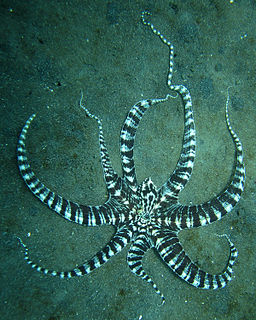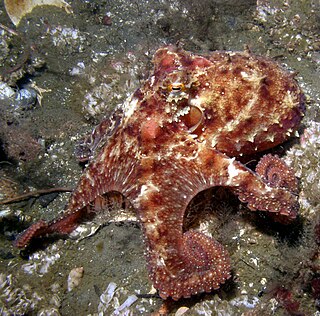
Los Jaivas is a Chilean musical group who perform in folk, rock, psychedelic, and progressive rock styles formed in 1963 in Viña Del Mar, Chile. They are considered one of the most important and influential artists of all time in Latin America.

Blue-ringed octopuses, comprising the genus Hapalochlaena, are four highly venomous species of octopus that are found in tide pools and coral reefs in the Pacific and Indian oceans, from Japan to Australia. They can be identified by their yellowish skin and characteristic blue and black rings that change color dramatically when the animal is threatened. They eat small crustaceans, including crabs, hermit crabs, shrimp, and other small sea animals.

The mimic octopus is an Indo-Pacific species of octopus from the Indo-Pacific region. Like other octopuses, it uses its chromatophores to disguise itself with its background. However, it is noteworthy for being able to impersonate a wide variety of other marine animals. Although many animals mimic either their environment or other animals to avoid predation, the mimic octopus and its close relative the wunderpus are the only ones known to actively imitate a number of animals in order to elude predators.

Enteroctopus is an octopus genus whose members are sometimes known as giant octopus.

Octopus is the largest genus of octopuses, comprising more than 100 species. These species are widespread throughout the world's oceans. Many species formerly placed in the genus Octopus are now assigned to other genera within the family Octopodidae.

The giant Pacific octopus, also known as the North Pacific giant octopus, is a large marine cephalopod belonging to the genus Enteroctopus. Its spatial distribution includes the coastal North Pacific, along California, Oregon, Washington, British Columbia, Alaska, Russia, Japan, and Korean Peninsula. It can be found from the intertidal zone down to 2,000 m (6,600 ft), and is best adapted to cold, oxygen-rich water. It is the largest octopus species, based on a scientific record of a 71-kg (156-lb) individual weighed live.

Octopus rubescens is the most commonly occurring shallow-water octopus on much of the North American West Coast, and a ubiquitous benthic predator in these habitats. Its range extends from the southern Gulf of California at least to the Gulf of Alaska, but may also occur in the western Pacific Ocean. O. rubescens occurs intertidally to a depth of 300 m.
Semirossia patagonica is a species of bobtail squid native to the southwestern Atlantic Ocean and southeastern Pacific Ocean; it occurs around the southern part of South America and has been recorded from waters off Chile, Anegada Bay, Tierra del Fuego, Argentina, and the Falkland Islands.

Robsonella is a small genus of octopuses in the family Octopodidae. It contains two described species. Robsonella octopuses can be found on the central-south coast of Chile. If an octopus’ first lateral tooth in the radula is crescent shaped; this allows you to identify it as a Robsonella fontaniana. One species in the genus, Robsonella fontaniana, inhabit the coastal waters of Chile and range from northern Peru to Golfo Nuevo in Argentina. Robsonella fontaniana are very small, have rugged skin and each eye has a fleshy expansion.

Enteroctopus magnificus, also known as the southern giant octopus, is a large octopus in the genus Enteroctopus. It is native to the waters off Namibia and South Africa.

Eledone moschata, the musky octopus, is a species of octopus belonging to the family Octopodidae.

Leonerasaurus is a basal genus of sauropodomorph dinosaur. Currently, there is only one species known, named L. taquetrensis by Diego Pol, Alberto Garrido and Ignacio A. Cerda in 2011. The fossil, an incomplete subadult individual, was found in the Las Leoneras Formation in Argentina. This formation is probably Early Jurassic in age. Leonerasaurus was a small non-sauropod sauropodomorph, showing an unusual combination of basal and derived characters. This indicates that the evolution of early sauropodomorphs witnessed a great degree of convergent evolution.

The development of octopus aquaculture, the farming of octopus, is being driven by strong market demands in the Mediterranean and in South American and Asian countries. Octopus live short lives, growing rapidly and maturing early. They typically reach two or three kilograms. There is little overlap between successive generations.
Aggregata is a genus of parasitic alveolates belonging to the phylum Apicomplexa.
Eledone massyae, the combed octopus, is a small benthic octopus found off the Atlantic coasts of southern South America, particularly Argentina and southern Brazil.

The Chacabuco River is a river of Chile located in the Aysén del General Carlos Ibáñez del Campo Region. The river rises in a col between Cerro Lucas Bridges and Cerro Baker. The latter is a mountain on the Argentina-Chile border, close to Roballos Pass.

Octopus mimus is commonly found between northern Peru and northern Chile. The species is relatively large with a round sacciform mantle without fins. The tentacles are moderately large, approximately 4 times longer than the mantle. The 3rd tentacle on the right holds the short, thin copulatory organ in males. The color ranges, with individuals commonly speckled a mix of gray, yellow, black, green. It is primarily benthic, living in rocky substrates and kelp forests until depths of 200 m. The species is dicecious, breeding throughout the year with one or two peaks depending on the latitude. After mating the female cares for the eggs letting her body deteriorate until death. This animal grows up to 115 cm in length and 3.7 kg in females and 107 cm in length and 4.4 kg in males. Juveniles can double in size ever 30 to 60 days. The Gould octopus is an opportunistic predator feeding primarily on crustaceans, mollusks, fish, and echinoderms. This species is also commonly fished in Peru and Chile.
Octopus insularis is a species of octopus described in 2008 from individuals found off the coast of Brazil, with a potentially much larger range.
Julio Lamilla was a Chilean biologist, researcher and conservationist. Lamilla was a former student of Liceo Armando Robles Rivera in Valdivia before graduating from the Austral University of Chile in Biology and Chemistry in which he majored in Zoology.













